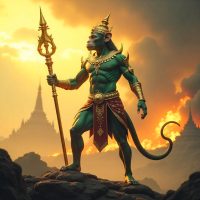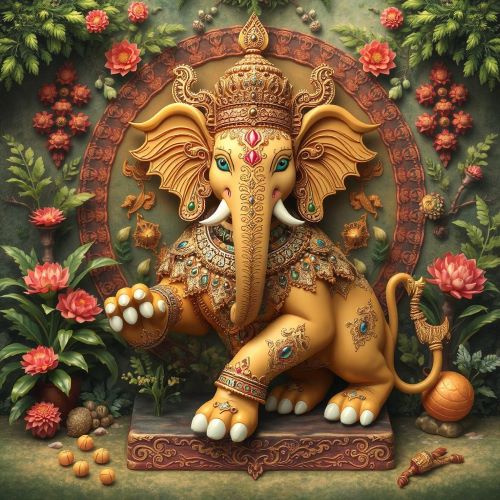Ongkot : Guardian Warrior of the Thai Ramakien
Listen
At a glance
| Description | |
|---|---|
| Origin | Thai Mythology |
| Classification | Hybrids |
| Family Members | N/A |
| Region | Thailand |
| Associated With | Bravery, Warrior |
Ongkot
Introduction
Ongkot (Thai: องคต) stands as one of the most loyal and valiant vanaras in Thai mythology, deeply rooted in the Ramakien, Thailand’s national epic inspired by the Ramayana of India. As a devoted commander in Phra Ram’s (Rama’s) army, Ongkot symbolizes courage, duty, and wisdom. Though Hanuman often takes center stage in popular retellings, Ongkot’s contributions are no less vital. His daring missions, strategic insight, and unyielding faith make him a pillar of the vanara ranks and a revered figure in Thai storytelling. The narrative of Ongkot highlights the essence of heroism that transcends brute strength—his story exemplifies loyalty to the divine cause, the strength of moral conviction, and the harmony between duty and destiny.
Physical Traits
Ongkot’s physical appearance blends the majesty of divine beings with the fierce vitality of nature. Traditionally depicted as a green-skinned vanara, his color signifies energy, fertility, and celestial favor. His body is muscular and well-proportioned, exuding a sense of restrained power suited to a seasoned warrior. His long, flexible tail—often described as possessing mystical properties—is not merely ornamental but a symbol of his dexterity and spiritual lineage. In Khon performances, Ongkot’s character is represented through a green mask adorned with golden headgear and intricately detailed armor, highlighting both his noble status and divine heritage. His expressive eyes and commanding posture convey intelligence, readiness, and the instinctive courage that define his role as a warrior of the gods.
Family
Ongkot’s lineage underscores his complex place within the mythological world of the Ramakien. His father, Pali (or Bali in Sanskrit), was the mighty vanara king whose strength was unmatched among his kin. His mother, Nang Monto, was once associated with Totsakan (Ravana), the central antagonist of the epic, before being taken by Pali. This unusual parentage makes Ongkot both a relative of the vanara allies and distantly tied by circumstance to the demonic forces of Lanka. After his father’s death at the hands of Phra Ram, Ongkot continues his service under Sukreep (Sugriva), his uncle, and joins the divine army in their battle to reclaim righteousness. In certain Thai versions, Ongkot’s birth is described as miraculous—a result of divine intervention where a sage transfers the unborn child into a goat’s womb to complete gestation, signifying his unique and sacred destiny. His familial background not only enriches his personal identity but also represents the intricate interweaving of divine justice, karma, and redemption within Thai mythology.
Other names
While Ongkot remains his most recognized name across Thai sources, slight variations appear due to linguistic and cultural differences. Romanized versions such as Onkot, Ongkhot, and Onkotto can be found in international adaptations and digital storytelling. Japanese media, particularly in franchises like Shin Megami Tensei, have incorporated him as Onkotto, further demonstrating his cross-cultural appeal. Despite these phonetic differences, the character’s essence remains constant—an emblem of valor and service to righteousness. Unlike other mythological figures who undergo identity shifts across regional interpretations, Ongkot retains a singular clarity of purpose and representation within Thai mythology, reinforcing his stature as a steadfast and reliable warrior.
Powers and Abilities
Ongkot’s powers blend physical prowess with divine endowment, embodying the archetype of a warrior-saint. His most notable attribute is his extraordinary strength, capable of overpowering even the fiercest asuras (demons) in direct combat. Like other vanaras, he possesses the ability to alter his size—expanding to colossal heights or shrinking to microscopic dimensions as the situation demands. His agility and speed are legendary, allowing him to leap vast distances and traverse great landscapes in moments, a gift that makes him an ideal scout and messenger for Phra Ram.
In several Ramakien episodes, Ongkot demonstrates remarkable intelligence and battlefield awareness. His encounter with the demon Paklan, who guards a cursed pond, is a testament to both his might and moral depth. Ongkot defeats the demon not out of hatred, but compassionately frees him from his curse—an act illustrating that true strength lies in mercy as much as in combat skill. Another of his famed abilities is his use of his tail, which can stretch to immense lengths. This is notably employed in extinguishing the fires of Lanka, symbolizing his role as both protector and savior in the face of destruction. Beyond these feats, Ongkot’s spiritual purity and loyalty amplify his power, making him a conduit of divine will in the ongoing war between good and evil.
Modern Day Influence
In contemporary Thailand, Ongkot continues to inspire reverence and creativity. His image appears prominently in murals and bas-reliefs at temples such as Wat Phra Kaew (Temple of the Emerald Buddha), where scenes from the Ramakien come alive in vivid color and intricate detail. In these depictions, Ongkot often stands alongside Hanuman and other vanara heroes, symbolizing unity, courage, and devotion to dharma.
Traditional Khon dance dramas frequently feature Ongkot in major performances, with the “Ongkot Meets Paklan” episode remaining one of the most popular. His character is brought to life through elaborate choreography and expressive gestures that showcase both valor and grace. Beyond the stage, his influence has extended into literature, educational curricula, and visual media. School textbooks and children’s story collections include simplified versions of his adventures, introducing younger generations to the moral and cultural foundations of the Ramakien.
In recent years, digital culture and global media have revived interest in Ongkot’s mythology. He has appeared in adaptations within video games, manga, and animated retellings, where he is often reimagined as a guardian spirit or mythical warrior. These reinterpretations, while modern in form, preserve his essential traits—loyalty, bravery, and spiritual strength. In Thai society, Ongkot embodies virtues deeply cherished across generations: faithfulness to one’s duty, resilience in adversity, and the quiet dignity of a true hero.
Related Images
Source
Anonymous. (n.d.). The Ramakien (Thai Ramayana) of King Rama II. http://www.thairamayana.com/ramakien-of-rama-II.pdf
Naiin, T. (2024). Characters in Thai mythology. SEAsite, Northern Illinois University. https://seasite.niu.edu/thai/Sikaeo/character.htm
Wikipedia contributors. (2024, June 11). Category: Thai mythology. Wikipedia. https://en.wikipedia.org/wiki/Category:Thai_mythology
Pornrat Damrhung. (2019). Working between two worlds: New roles for traditional Thai dance and dancers. Manusya: Journal of Humanities, https://digital.car.chula.ac.th/cgi/viewcontent.cgi?article=1282&context=manusya
Anonymous. (n.d.). Text from Ramakien. SEAsite, Northern Illinois University. https://web.archive.org/web/20090814193402/http:/www.seasite.niu.edu:85/Thai/literature/ramakian/text.htm
Learn Alchemical. (2021, November 7). Tuwaang: The craftsman warrior. https://www.learnalchemical.com/post/tuwaang-the-craftsman-warrior
Wikipedia contributors. (2006, December 7). Khun Chang Khun Phaen. Wikipedia. https://en.wikipedia.org/wiki/Khun_Chang_Khun_Phaen
Wikipedia contributors. (2024). Ramakien. Wikipedia. Retrieved from https://en.wikipedia.org/wiki/Ramakien
Petprakob, S., Vannalee, C., & Sukprasert, N. (2024). The Roles of Ongkot in the Khon Performance, the Episode of Ongkot Meets the Ogre Paklan. Bansomdejchaopraya Rajabhat University. Retrieved from https://culture.bsru.ac.th/wp-content/uploads/2024/06/05-ทีทัศน์-23-ฉ-1-ปี-67-บทบาทขององคตในการแสดงโขนฯ.pdf
Chaiwat, T. (2019). Ramakien: The Thai Ramayana. Bangkok: River Books.
Piriya, K. (2015). Khon and Thai Classical Dance. Bangkok: Silpakorn University Press.
Srisakdi, C. (2012). Mythical Creatures in Thai Literature. Chiang Mai: Lanna Heritage Publications.
Phongpaichit, P., & Baker, C. (2017). A History of Thailand. Cambridge University Press.
Ministry of Culture Thailand. (2020). Characters of Ramakien. Retrieved from http://www.culture.go.th/ramakien/characters/ongkot
Frequently Asked Questions
Who is Ongkot in Thai mythology?
Ongkot (องคต) is a loyal monkey warrior in Thai mythology, appearing in the Ramakien (รามเกียรติ์), Thailand’s national epic. He serves under Hanuman ( หนุมาน ) and supports Phra Ram ( พระราม ) in the great war against the demon king Totsakan ( ทศกัณฐ์ ), the Thai version of Ravana.
What is Ongkot known for in the Ramakien?
In the Ramakien, Ongkot is known for his unwavering discipline, obedience, and courage. He frequently acts as a trusted warrior in missions led by Hanuman, participating in reconnaissance, battle support, and key operations that aid Phra Ram in his conflict with Totsakan.
Is Ongkot related to Hanuman?
Ongkot is not a blood relative of Hanuman, but he is one of the most trusted monkey warriors under Hanuman’s command. Their relationship in the Ramakien reflects deep loyalty, respect, and military brotherhood within the monkey army known as the Wanara.
What qualities make Ongkot an important character in Thai culture?
Ongkot embodies virtues highly valued in Thai culture—loyalty, humility, discipline, and unwavering service to a noble cause. His devotion to Phra Ram and steadfast support of Hanuman highlight the Thai ideals of duty, respect, and righteous action.
How is Ongkot portrayed in Thai art and performance?
In traditional Khon ( โขน ) masked dance and temple murals, Ongkot is portrayed as a noble monkey warrior wearing ornate armor, often standing beside Hanuman. His depictions emphasize his obedience, strength, and dedication to the forces of Phra Ram as they battle Totsakan.












